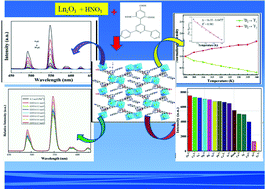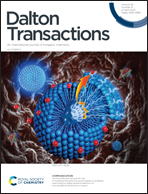Multi-functional lanthanide-CPs based on tricarboxylphenyl terpyridyl ligand as ratiometric luminescent thermometer and highly sensitive ion sensor with turn on/off effect†
Abstract
A series of isostructural lanthanide coordination polymers (Ln-CPs) formulated as [Ln(tcptpy)(H2O)2·2H2O]n {Ln3+ = Sm3+ (1), Eu3+ (2), Gd3+ (3), Tb3+ (4), Dy3+ (5); H3tcptpy = 4-(2,4,6-tricarboxylphenyl)-4,2′:6′,4′′-terpyridine} has been afforded and characterized systematically. Their structures were established by single-crystal X-ray diffraction. All the complexes feature two dimensional (2D) layers with (4,4)-connected topology. By virtue of the isostructural frameworks, a family of binary co-doped Ln-CPs [Tb1−xEuxtcptpy]n was achieved for ratiometric temperature sensors, among which Tb0.897Eu0.103tcptpy exhibits a good linear response to the temperature range from 305–340 K, with a maximum relative sensitivity (Sm) of 8.41% K−1 at 340 K. Moreover, Tb-CPs exhibit excellent applications as luminescent sensors for the detection of nitrobenzene and Fe3+ cations with high selectivity and sensitivity based on a luminescence quenching approach. The possible mechanisms of the fluorescence quenching effect were also investigated.



 Please wait while we load your content...
Please wait while we load your content...